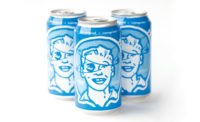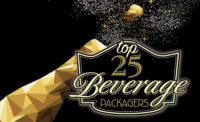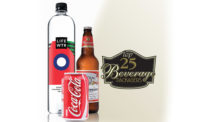Cover Story: Food and beverage packaging
Food & beverage packaging disrupting the shelves
Food and beverage aisles exhibit niche products with an artistic and organic flair.

New packaging formats, sizes and designs, as well as product offerings, are disrupting grocery stores everywhere.

Jerky is a booming snack segment for health-conscious consumers who want a high-protein snack that will keep them fuller, longer.

Sold in refrigerated cases, these baby foods feature a clear window on the pouch to see the contents and a convenient stand-up pouch with twist-off cap.

The clear label, as well as clear glass, lends a transparent, honest presentation showcasing the product inside.

Fully compostable packaging was launched as a way to encourage other brands in the industry to follow suit.





Take a look around next time you’re at your favorite grocery store. What you’re bound to see is that most stores are beefing up their once small and secluded health section, into aisles and aisles of organic, free-from and healthier options. These packages are touting big health claims and eco-friendly materials, all while sporting quirky and creative designs to draw consumers in. But research shows that functionality may be even more important than aesthetics to consumers. New packaging formats, sizes and designs, as well as product offerings, are disrupting grocery stores everywhere, leaving behind the popular foods of just 10 years ago.
More than a green thumb
Eco-conscious packaging has always been a popular way for packagers to get noticed on shelves. Today’s consumers, especially the Millennials and younger Gen Z bunch, place high importance on sustainability. One bakery out of California launched a fully compostable line of packaging for its organic products. Sugar Bowl Bakery’s fully compostable line is a continuation of the company’s strategy to have a positive impact on the environment and is as a way to encourage other brands in the industry to follow suit.
The components of the new organic packaging for the bakery’s popular Organic Brownie Bites and Organic Madeleines are sourced locally when possible. For example, the recycled paperboard used for the carton is produced using the waste paper from local retailers within a 150-mile radius of the paperboard plant, which is just 30 miles south of Sugar Bowl Bakery’s Hayward, CA, plant. Each component of the package has been verified compostable, even the wrapper around the cakes and cookies.
“We are proud to be among the first to embrace compostable packaging in our bakery department…,” says Pete Thomsen, director of sales at Sugar Bowl Bakery. “Ultimately, this provides our retail partners with a strong statement to stand with us in reducing the carbon footprint in the industry. Many consumers embrace the idea of organic products at this point, so a product that, first and foremost is great tasting, and then in addition reduces the greenhouse gases associated with the packaging by 72% is a product I think consumers will be excited to try, to love and tell friends and family about.”
The award-winning bakery’s lines of high-quality baked goods are sold at various supermarket chains and warehouse clubs.
Health and wellness reign
Today’s consumers want sustainability, healthy and natural, and even organic products that promise a better future for both the world and their bodies. And not many groups of consumers strive for it more than new parents. In response, Once Upon a Farm launches fresh, high-pressure processed (HPP) organic baby food that is disrupting baby food aisles. Sold in refrigerated cases (not right out on the shelf), these baby foods feature a clear window on the pouch to see the delicious contents, whimsical graphics and a convenient stand-up pouch with twist-off cap.
HPP has brought a whole new facet to baby food, encouraging parents to ditch shelf-stable (and often preservative-laden) varieties in favor of fresh, high-quality fruits and veggies just like nature intended them. The packages still have the convenience of traditional baby food pouches, but offer the freshness and wholesomeness of homemade baby food, without the work.
“Being a fresh, refrigerated product does not affect the packaging. We are proud to be the first baby food on the market to offer a clear window on our eco-friendly pouches, so parents can see the vibrant colors and textures of the real food inside. Our food is also convenient. Instead of moms or dads doing all the homemade work, we are doing it for them. Plus, our pouches can easily be taken on the go with an ice pack in a cooler bag or be frozen and then thawed on the go,” says Cassandra Curtis, COO and co-founder of Once Upon a Farm.
Beverages have long offered consumers health benefits and functionality with vitamin-infused waters, organic teas and plant waters growing significantly in recent years. Thea’s English Standard Tea is an eight SKU range of all-natural, zero calorie, sugar-free iced tea with complex flavors like black rose, honeysuckle, smokey lemon and dandelion mint. Until recently, the brand had a very small distribution, so as part of an effort to expand distribution, Thea’s embarked on a package design and rebranding project. The brand’s values and positioning needed to be conveyed as a healthy and sophisticated alternative for savvy consumers.
The new brand design aims to reflect that sophistication, as well as communicate its natural taste. The glass bottle is a French square 16-ounce glass bottle with a custom 48mm lug neck finish for easy holding and drinking. The faceted corners enhance the bottle, creating a jewel-like presentation, which strongly stands apart from competitors in the iced tea category.
The clear label, as well as clear glass, lends a transparent, honest presentation showcasing the product inside and making the flavors obvious to consumers, just by looking at the package. The brand design conveys a healthful and botanical theme to show off the clean, delicious tea. Bright, fresh colors punctuate the flavor identifier bars, a zero-calorie stamp and the leaf-shaped tittle.
Jerky is a booming snack segment for health-conscious consumers who want a high-protein snack that will keep them fuller, longer. Six years ago Field Trip emerged in a sleepy category with a mission to deliver a healthier, all-natural jerky. Since then, the segment has boomed and the brand got a redesign to further stand out on the shelf and to showcase the fun, quirky brand.
Founded in 2010 by three friends, Scott Fiesinger, Tom Donigan and Matt Levey, Field Trip Jerky is a protein-packed, portable and healthy snack, perfect for fueling any adventure. Available nationally at Starbucks and at a growing number of natural food retailers, Field Trip Jerky is all natural and does not contain MSG, nitrates, preservatives or high-fructose corn syrup.
According to the brand, Field Trip was the first to introduce a convenient side-open pouch design to jerky, allowing easier access to the product inside. As new brands entered the market, the brand decided on a rebranding effort with the goal to be unlike any other package on the shelf, to provide a sense of discovery and above all else easily convey the great product packaged inside.
Field Trip enlisted the help of Moxie Sozo (moxiesozo.com) to transform the brand’s ‘get out there’ tag line to the act of adventure. The design features hand illustrated national park impressions; each package portrays a different U.S. National Park (Yosemite, Big Bend, Acadia, Arches, Bryce Canyon, Zion and Grand Tetons). The result is a fun and interesting package that stands out in this now-popular segment.
Packaging must perform
While quirky designs, new flavor trends and eco-friendly products all attract new consumers, package function and user-friendliness really is the deciding factor. WestRock’s (westrock.com) recent study, Packaging Matters, reveals the impact of packaging on product satisfaction and consumer purchasing behavior. This year’s survey of 2,000 consumers found that the importance of packaging to U.S. consumers has increased over the past two years. However the importance is not so much on the aesthetics of packaging, but rather the function.
“We are seeing loud and clear that consumers are focused on safety and functionality,” says Erin Weinland, director of consumer insights, WestRock.
After four years of tracking consumer satisfaction and purchasing decisions, this year’s Packaging Matters study reinforced key trends, including:
- Packaging is as important as the brand. The importance of packaging to product satisfaction has increased over the past two years, up from 18% to 26%, while the importance of brand to satisfaction has decreased from 30% to 26% in the same period.
- Safety remains a top area of concern. Because 81% of consumers say that product safety is important to their satisfaction with the products they purchase and use, brands and companies are expected to make choices about packaging that keep consumers and their families safe.
- Beverage packaging tops the satisfaction list; takeout meals and beverages need improvement. Nearly 7 in 10 consumers are very or completely satisfied with both non-alcoholic and alcoholic beverage packaging, while less than half are satisfied with packaging for to-go meals and beverages.
WestRock also surveyed 200 professionals who work at consumer packaged goods companies and have influence over brands’ packaging decisions. The survey found that this group recognized packaging’s importance but, while 66% of packaging professionals say that their brand is already making a strong effort to improve packaging to meet consumer needs, only 14% strongly agree with that statement. There is a noticeable difference in perspective of packaging between consumers and professionals.
The study shed light on some of the differences between the two groups and some opportunities for packagers to improve, and ultimately drive consumer satisfaction. U.S. consumers are very focused on packaging doing a job, like protecting the content inside, keeping it safe and delivering it to them intact; 70-80% say it’s important that the package keeps the product safe and prevents spilling, leaking and breaking.
On the other end, packagers focus more on having a unique design and aesthetics. They place more emphasis here but it turns out that consumers don’t really care, or at least say that they don’t. Only 20% say aesthetics is important. Consumers are more focused on how packaging works.
Package functionality and user-friendliness is a must with today’s consumers. Without that, the package is just another pretty face in a sea of pretty faces. While whimsical designs and clean labeling do attract consumers, they place more emphasis on the package’s overall function. But when a product can do it all, that makes for the best disruption of all.
Looking for a reprint of this article?
From high-res PDFs to custom plaques, order your copy today!













